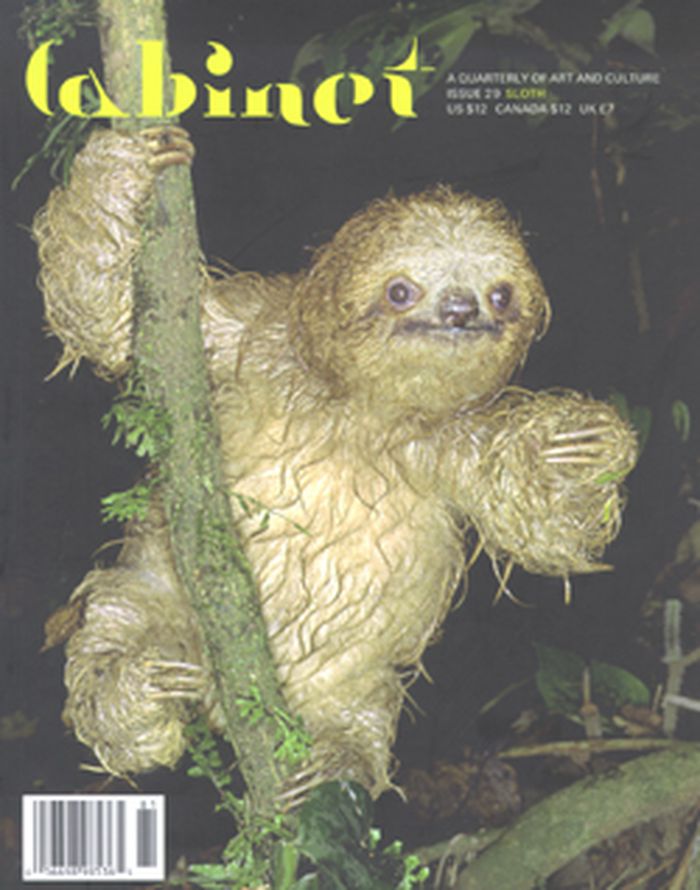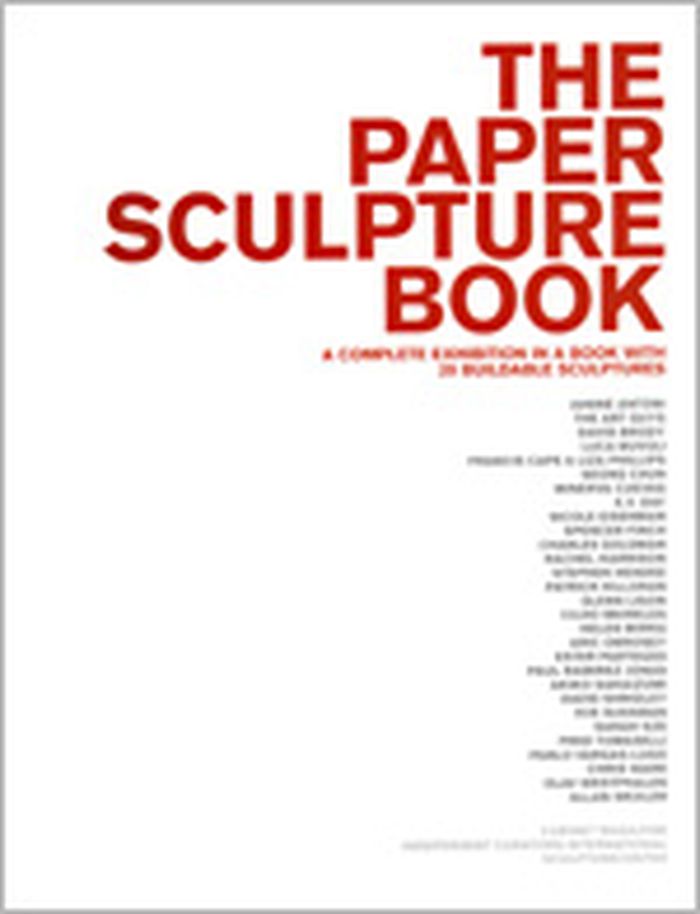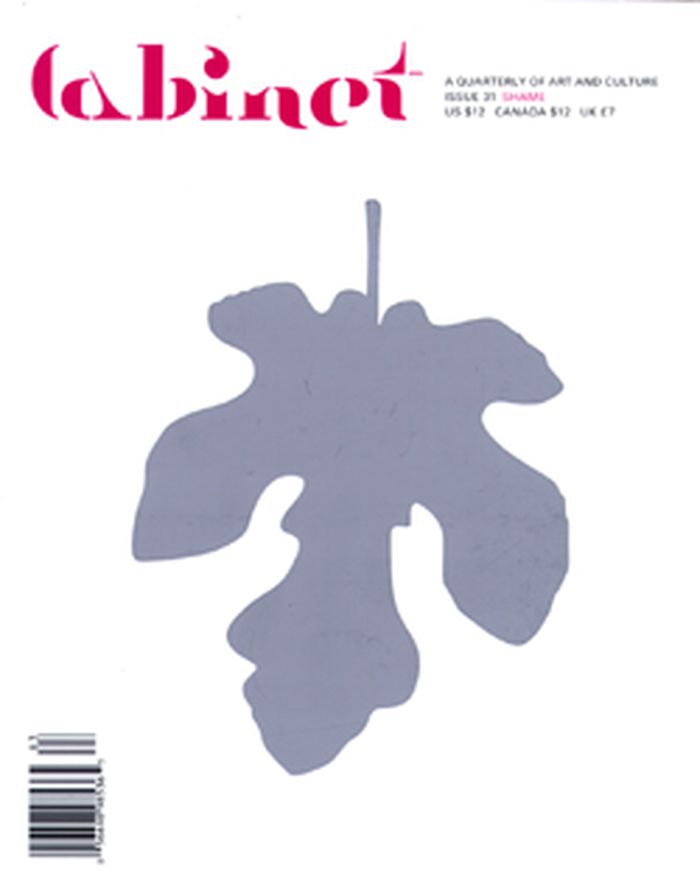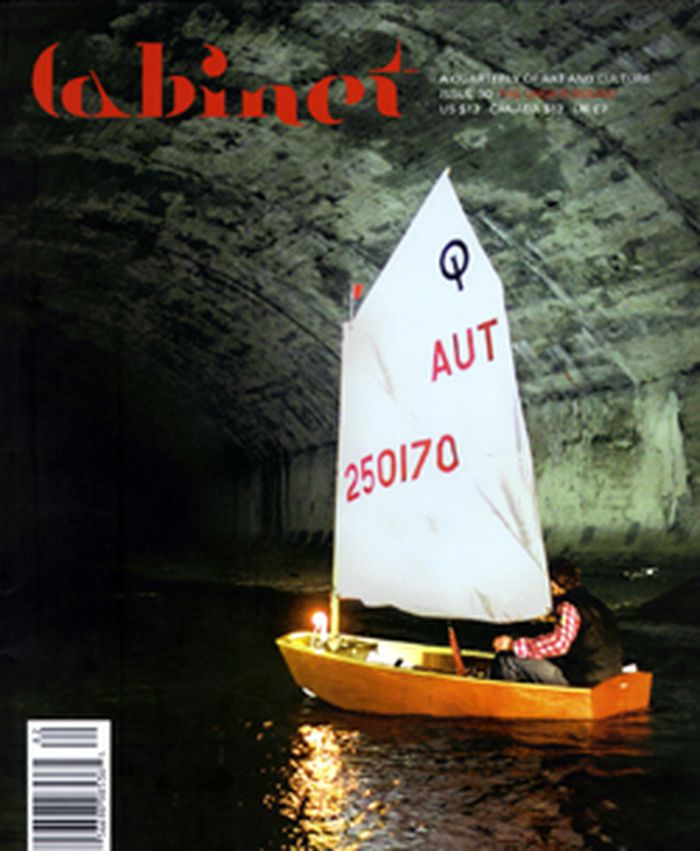Cabinet 29 Sloth
$14.00
(available in store)
Summary:
Items of interest for balkers, Bartlebys, benchwarmers, and boondogglers: - Dan Rosenberg on busy idleness - Marina van Zuylen on the intellectual history of lassitude - Christopher Turner on vasectomania and other cures for sloth - A history of the recline of civilization - Sina Najafi interviews Pierre Saint-Amand on the loafers of the Enlightenment - At(...)
Cabinet 29 Sloth
Actions:
Price:
$14.00
(available in store)
Summary:
Items of interest for balkers, Bartlebys, benchwarmers, and boondogglers: - Dan Rosenberg on busy idleness - Marina van Zuylen on the intellectual history of lassitude - Christopher Turner on vasectomania and other cures for sloth - A history of the recline of civilization - Sina Najafi interviews Pierre Saint-Amand on the loafers of the Enlightenment - At long last, a CliffsNotes for Cabinet! And ample additional material for dawdlers, deadbeats, derelicts, dodgers, and do-nothings: - Mark Morris on gingerbread houses - Joshua Foer on time without clocks - Carolyn de la Peña on Gustav Zander’s Stairmaster prototypes - San Keller’s artist project, set in a Rome sunglass shop - Brian Dillon on the water cure - Emily Roysdon opines on opal - Margaret Wertheim interviews Kenneth Libbrecht on snowflake formation - Alexander R. Galloway and McKenzie Wark play a Guy Debord game - Frances Richard and Emilie Clark discuss the lives of women natural historians
Magazines, Back Issues
The paper sculpture book
$36.00
(available to order)
Summary:
"The paper sculpture book" is published on the occasion of the traveling exhibition "The paper sculpture show", organized by Cabinet magazine, Independant Curators International (ICI), and SculptureCenter, and curated by ICI. Artworks meant to be cut out by the reader and assembled using very basic materials such as tape and rubber bands have been designed by 29(...)
Group Exhibitions
October 2003, Brooklyn
The paper sculpture book
Actions:
Price:
$36.00
(available to order)
Summary:
"The paper sculpture book" is published on the occasion of the traveling exhibition "The paper sculpture show", organized by Cabinet magazine, Independant Curators International (ICI), and SculptureCenter, and curated by ICI. Artworks meant to be cut out by the reader and assembled using very basic materials such as tape and rubber bands have been designed by 29 established and emerging contemporary artists, including The Art Guys, Minerva Cuevas, Seong Chun, Nicole Eisenman, Spencer Finch, Rachel Harrison, Stephen Hendee, Patrick Killoran, Glenn Ligon, Helen Mirra, David Shrigley, Sarah Sze, Chris Ware and Allan Wexler. Fred Tomaselli merges images from a birding book and an outdoor-clothing catalogue to create an ironic yet beautiful aviary. Janine Antoni's Crumple provides precise instructions for recreating a crumpled ball of paper, while Luca Buvoli invites the reader to take a pop-up flying lesson from the mysterious Professor M.a.S.
Group Exhibitions
Cabinet 31 shame
$12.00
(available in store)
Summary:
Including Lauren Berlant, D. Graham Burnett, Amy Cutler, Marilyn Ivy, Jonathan Ames, Renata Salecl, Alan Jacobs, Leland de la Durantaye, and more
Cabinet 31 shame
Actions:
Price:
$12.00
(available in store)
Summary:
Including Lauren Berlant, D. Graham Burnett, Amy Cutler, Marilyn Ivy, Jonathan Ames, Renata Salecl, Alan Jacobs, Leland de la Durantaye, and more
Magazines
Cabinet 30: The Underground
$13.00
(available in store)
Summary:
Site of hidden infrastructure, source of material and energy, home to clandestine activity, buried landscape of darkness and silence: the physical and emotional space of the underground is at once prosaic and uncanny, rich with both functional potential and metaphorical meaning. Cabinet issue 30, with its special section on The Underground, features Irene Cheng on Thomas(...)
Cabinet 30: The Underground
Actions:
Price:
$13.00
(available in store)
Summary:
Site of hidden infrastructure, source of material and energy, home to clandestine activity, buried landscape of darkness and silence: the physical and emotional space of the underground is at once prosaic and uncanny, rich with both functional potential and metaphorical meaning. Cabinet issue 30, with its special section on The Underground, features Irene Cheng on Thomas W. Knox's 1876 book Underground, or Life Below the Surface and the vogue for underground tourism; an interview with Michel Siffre, a scientist who spent six months isolated in utter darkness in a cave; Jeffrey Kastner on the metaphor of the mole in revolutionary texts; and essays on the evolution of the mining industry, subterranean storage and political resistance movements. Elsewhere in the issue: Christopher Turner on the history of Day-glo; Christine Wertheim on the fabricated Australian Modernist poet Ern Malley; Tirdad Zolghadr on in-flight magazines; and Moyra Davey on the color maroon. This issue also features artist projects by Josiah McElheny and San Keller.
Magazines
journals and magazines
$11.00
(available to order)
Summary:
Cabinet is an award-winning quarterly magazine of art and culture that confounds expectations of what is typically meant by the words "art," "culture," and sometimes even "magazine." Like the 17th-century cabinet of curiosities to which its name alludes, Cabinet is as interested in the margins of culture as its center. Presenting wide-ranging, multi-disciplinary content(...)
Cabinet 18 : fictional states, 2005
Actions:
Price:
$11.00
(available to order)
Summary:
Cabinet is an award-winning quarterly magazine of art and culture that confounds expectations of what is typically meant by the words "art," "culture," and sometimes even "magazine." Like the 17th-century cabinet of curiosities to which its name alludes, Cabinet is as interested in the margins of culture as its center. Presenting wide-ranging, multi-disciplinary content in each issue through the varied formats of regular columns, essays, interviews, and special artist projects, Cabinet's hybrid sensibility merges the popular appeal of an arts periodical, the visually engaging style of a design magazine, and the in-depth exploration of a scholarly journal. Playful and serious, exuberant and committed, Cabinet's omnivorous appetite for understanding the world makes each of its issues a valuable sourcebook of ideas for a wide range of readers, from artists and designers to scientists and historians. In an age of increasing specialization, Cabinet looks to previous models of the well-rounded thinker to forge a new type of magazine for the intellectually curious reader of the future.
journals and magazines
October 2005, New York
Magazines
journals and magazines
$12.00
(available to order)
Summary:
Cabinet is an award-winning quarterly magazine of art and culture that confounds expectations of what is typically meant by the words "art," "culture," and sometimes even "magazine." Like the 17th-century cabinet of curiosities to which its name alludes, Cabinet is as interested in the margins of culture as its center. Presenting wide-ranging, multi-disciplinary content(...)
Cabinet 15: the average, fall 2004
Actions:
Price:
$12.00
(available to order)
Summary:
Cabinet is an award-winning quarterly magazine of art and culture that confounds expectations of what is typically meant by the words "art," "culture," and sometimes even "magazine." Like the 17th-century cabinet of curiosities to which its name alludes, Cabinet is as interested in the margins of culture as its center. Presenting wide-ranging, multi-disciplinary content in each issue through the varied formats of regular columns, essays, interviews, and special artist projects, Cabinet's hybrid sensibility merges the popular appeal of an arts periodical, the visually engaging style of a design magazine, and the in-depth exploration of a scholarly journal. Playful and serious, exuberant and committed, Cabinet's omnivorous appetite for understanding the world makes each of its issues a valuable sourcebook of ideas for a wide range of readers, from artists and designers to scientists and historians. In an age of increasing specialization, Cabinet looks to previous models of the well-rounded thinker to forge a new type of magazine for the intellectually curious reader of the future.
journals and magazines
February 2004, New York
Magazines
journals and magazines
$12.00
(available to order)
Summary:
Cabinet is an award-winning quarterly magazine of art and culture that confounds expectations of what is typically meant by the words "art," "culture," and sometimes even "magazine." Like the 17th-century cabinet of curiosities to which its name alludes, Cabinet is as interested in the margins of culture as its center. Presenting wide-ranging, multi-disciplinary content(...)
Cabinet 12: the enemy, fall 2003 - winter 2004
Actions:
Price:
$12.00
(available to order)
Summary:
Cabinet is an award-winning quarterly magazine of art and culture that confounds expectations of what is typically meant by the words "art," "culture," and sometimes even "magazine." Like the 17th-century cabinet of curiosities to which its name alludes, Cabinet is as interested in the margins of culture as its center. Presenting wide-ranging, multi-disciplinary content in each issue through the varied formats of regular columns, essays, interviews, and special artist projects, Cabinet's hybrid sensibility merges the popular appeal of an arts periodical, the visually engaging style of a design magazine, and the in-depth exploration of a scholarly journal. Playful and serious, exuberant and committed, Cabinet's omnivorous appetite for understanding the world makes each of its issues a valuable sourcebook of ideas for a wide range of readers, from artists and designers to scientists and historians. In an age of increasing specialization, Cabinet looks to previous models of the well-rounded thinker to forge a new type of magazine for the intellectually curious reader of the future.
journals and magazines
February 2004, New York
Magazines
journals and magazines
Cabinet 23: fruits
$11.00
(available in store)
Summary:
Cabinet is an award-winning quarterly magazine of art and culture that confounds expectations of what is typically meant by the words "art," "culture," and sometimes even "magazine." Like the 17th-century cabinet of curiosities to which its name alludes, Cabinet is as interested in the margins of culture as its center. Presenting wide-ranging, multi-disciplinary content(...)
Cabinet 23: fruits
Actions:
Price:
$11.00
(available in store)
Summary:
Cabinet is an award-winning quarterly magazine of art and culture that confounds expectations of what is typically meant by the words "art," "culture," and sometimes even "magazine." Like the 17th-century cabinet of curiosities to which its name alludes, Cabinet is as interested in the margins of culture as its center. Presenting wide-ranging, multi-disciplinary content in each issue through the varied formats of regular columns, essays, interviews, and special artist projects, Cabinet's hybrid sensibility merges the popular appeal of an arts periodical, the visually engaging style of a design magazine, and the in-depth exploration of a scholarly journal. Playful and serious, exuberant and committed, Cabinet's omnivorous appetite for understanding the world makes each of its issues a valuable sourcebook of ideas for a wide range of readers, from artists and designers to scientists and historians. In an age of increasing specialization, Cabinet looks to previous models of the well-rounded thinker to forge a new type of magazine for the intellectually curious reader of the future.
journals and magazines
November 2006, New York
Magazines
journals and magazines
$12.00
(available to order)
Summary:
Cabinet is an award-winning quarterly magazine of art and culture that confounds expectations of what is typically meant by the words "art," "culture," and sometimes even "magazine." Like the 17th-century cabinet of curiosities to which its name alludes, Cabinet is as interested in the margins of culture as its center. Presenting wide-ranging, multi-disciplinary content(...)
Cabinet 19: chance, fall 2005
Actions:
Price:
$12.00
(available to order)
Summary:
Cabinet is an award-winning quarterly magazine of art and culture that confounds expectations of what is typically meant by the words "art," "culture," and sometimes even "magazine." Like the 17th-century cabinet of curiosities to which its name alludes, Cabinet is as interested in the margins of culture as its center. Presenting wide-ranging, multi-disciplinary content in each issue through the varied formats of regular columns, essays, interviews, and special artist projects, Cabinet's hybrid sensibility merges the popular appeal of an arts periodical, the visually engaging style of a design magazine, and the in-depth exploration of a scholarly journal. Playful and serious, exuberant and committed, Cabinet's omnivorous appetite for understanding the world makes each of its issues a valuable sourcebook of ideas for a wide range of readers, from artists and designers to scientists and historians. In an age of increasing specialization, Cabinet looks to previous models of the well-rounded thinker to forge a new type of magazine for the intellectually curious reader of the future.
journals and magazines
January 2006, New York
Magazines
journals and magazines
$11.00
(available to order)
Summary:
Cabinet is an award-winning quarterly magazine of art and culture that confounds expectations of what is typically meant by the words "art," "culture," and sometimes even "magazine." Like the 17th-century cabinet of curiosities to which its name alludes, Cabinet is as interested in the margins of culture as its center. Presenting wide-ranging, multi-disciplinary content(...)
Cabinet 17: laughter, spring 2005
Actions:
Price:
$11.00
(available to order)
Summary:
Cabinet is an award-winning quarterly magazine of art and culture that confounds expectations of what is typically meant by the words "art," "culture," and sometimes even "magazine." Like the 17th-century cabinet of curiosities to which its name alludes, Cabinet is as interested in the margins of culture as its center. Presenting wide-ranging, multi-disciplinary content in each issue through the varied formats of regular columns, essays, interviews, and special artist projects, Cabinet's hybrid sensibility merges the popular appeal of an arts periodical, the visually engaging style of a design magazine, and the in-depth exploration of a scholarly journal. Playful and serious, exuberant and committed, Cabinet's omnivorous appetite for understanding the world makes each of its issues a valuable sourcebook of ideas for a wide range of readers, from artists and designers to scientists and historians. In an age of increasing specialization, Cabinet looks to previous models of the well-rounded thinker to forge a new type of magazine for the intellectually curious reader of the future.
journals and magazines
April 2005, New York
Magazines



